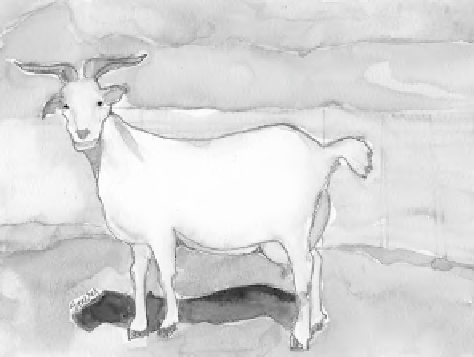Agriculture Reference
In-Depth Information
hair is coarse, males have beards, and their color usually
is black with some patches. It is a prolifi c breed with twin-
ning being very common.
Khurasani
Found in the border regions of Afghanistan and Iran and
also in Baluchistan in Pakistan, this dual-purpose breed is
valued for both meat and milk. The breed is horned, their
size is medium, and their color usually is black but they
may be white or grey. Adult males weigh about 25 kg
(55 lb), and females produce up to 1.3 kg (2.0 lb) of milk
per day. They produce a small amount of cashmere.
Kiko
Kiko means “ fl esh” or “meat” in Maori. This breed is a
composite developed in New Zealand from crossing feral
goats exhibiting good meat-type qualities with Anglo-
Nubian, Toggenburg, and Saanen bucks and is selected for
survivability and growth rate in hill country environments
(Mason, 1996). Established in 1986, the breed was imported
to the U.S. in the 1990s. This breed is hardy, resistant to
parasites, produces a lean carcass, and has good mothering
ability. In the U.S., Kiko goats and their crosses can be
registered by the International Kiko Goat Association either
as New Zealand Fullblood Kiko (NZFK), American Premier
Fullblood kiko (APFK), Percentage Kiko, American BoKi
(cross between NZFK or APFK and Fullblood Boer),
American MeatMaker (crosses between NZFK or APFK
and American BoKi), and International MeatMaker (crosses
between 15/16 Boer and American BoKi). Their color
usually is white or creamy. Adult does weigh more than
48.6 kg (107 lb) with some bucks weighing nearly 100 kg
(220 lb) (Taneja, 1982). They are very prolifi c and adapt
well to harsh environments. See Figure 2.1.
Figure 2.1
Kiko (Meat Goat). For color detail, see
Appendix A.
for the Southern Hill goats are 12 - 16 kg (27 - 35 lb) and
50 - 55 cm (20 - 22 in.).
Small East African
A very prominent breed across Kenya, Uganda, and
Tanzania (Devendra and Burns, 1983), this breed resem-
bles the goats raised by farmers in Rwanda, Malawi,
Zimbabwe, and Botswana. Their size is small with short
hair and short erect ears, and they vary in color. They are
used mainly for meat but also for their skins. They have
tassels. They are early maturing, but the twinning rate is
low. The types found in Uganda are very longhaired, and
they are favored for skins and their long hair. Adult goats
of this breed weigh about 30 kg (66 lb).
Somali
These goats have different names depending on the
country. In Somalia, they are known as Abgal or Modugh;
in Ethopia, they are called Ogaden or Benadir; while in
Kenya they are Galla or Boran. The breed is mainly used
for meat, but skins also are valued. Their coat color is
primarily white, and their ears and horns are short. Males
are horned, but females may be either horned or polled.
The breed is primarily adapted to dry areas (Mason and
Maule, 1960 ).
Nepalese Hill
The predominant breed of Nepal, this breed is found spread
across the Siwalik and Mahabharat hill regions of Nepal.
The Southern Hill goats are found in the Siwalik range
while the Northern Hill goats are spread in the Mahabharat
range. Their main use is for meat, but occasionally they
may be milked. They usually are brown or black with
white markings, or white with black markings. They are
named by their coat colors including Khairi, Kali, Seti,
Singari, or Dhobini. The Northern Hill goats are heavier
than the Southern Hill goats. The male Northern Hill goats
weigh about 35 - 45 kg (77 - 99 lb), while the females weigh
about 24 - 30 kg (53 - 66 lb). Wither heights are 60 - 70 cm
(24-28 in.) for adult males while adult females are 50-
65 cm (20 - 26 in.) (Epstein, 1977 ). Corresponding values
South African Meat Goat Breeds
B
OER
The Boer goats were derived from the indigenous goats
kept by Namaquo Hottentots and Southern Bantu tribes of







